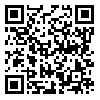دوره 18، شماره 19 - ( 4-1399 )
جلد 18 شماره 19 صفحات 161-147 |
برگشت به فهرست نسخه ها
Download citation:
BibTeX | RIS | EndNote | Medlars | ProCite | Reference Manager | RefWorks
Send citation to:



BibTeX | RIS | EndNote | Medlars | ProCite | Reference Manager | RefWorks
Send citation to:
Termeh M, Ghanbarzadeh A, Honarvar M, Heidari Shirazi K. Evaluation of optimal step length in a seven-link model with margin of stability method. RSMT 2020; 18 (19) :147-161
URL: http://jsmt.khu.ac.ir/article-1-440-fa.html
URL: http://jsmt.khu.ac.ir/article-1-440-fa.html
ترمه مهدیه، قنبرزاده افشین، هنرور محمدهادی، حیدری شیرازی کورش. ارزیابی طول گام بهینه در راهرفتن مدل هفتعضوی به روش حاشیۀ پایداری. پژوهش در طب ورزشی و فناوری. 1399; 18 (19) :147-161
، Ghanbarzadeh.A@scu.ac.ir
چکیده: (7185 مشاهده)
در طراحی حرکت راهرفتن، حفظ حداکثری تعادل، در کنار تأمین قیود سینماتیک و میزان انرژی مصرفی باید در کانون توجه قرار گیرد. در این پژوهش، هدف یافتن طول گام بهینه است. در این مطالعه، از یک تابع هزینۀ حداقل مصرف انرژی و هزینۀ افتادن استفاده شد. تابع هزینۀ افتادن با استفاده از مفهوم حاشیۀ پایداری و کمیت شاخص تعادل طراحی شد. برای بررسی وضعیت تعادل و بازسازی الگوی حرکتی، از حرکت راهرفتن طبیعی آزمودنیهای سالم دادهبرداری شد و الگویی هفتلینکی تعریف شد. در این پژوهش، مناسبترین طول گام برای فرد با قد و وزن و مشخصات دورۀ راهرفتن معلوم بهدست آمد. برای مثال، طول گام بهینه در راهرفتن فردی با قد 187 سانتیمتر و جرم 92 کیلوگرم، 54 سانتیمتر است. در این پژوهش با تحلیل راهرفتن فرد، ویژگیهای سینماتیکی و سینتیکی الگوی حرکتی او تشخیص داده شد. با محاسبۀ شاخص تعادل، به فرد در یافتن طول گام بهینهای که بهازای آن تعادل بیشینه میشود، کمک شده است. نتایج این مطالعه میتواند طول گام بهینه را با هدف اصلاح الگوی راهرفتن تعیین کند.
نوع مطالعه: پژوهشي |
دریافت: 1399/4/29 | پذیرش: 1399/4/25 | انتشار: 1399/4/25
دریافت: 1399/4/29 | پذیرش: 1399/4/25 | انتشار: 1399/4/25
فهرست منابع
1. Dyson, G.H.G. (1989). The Mechanics of Athletics. Holmes & Meier Publishers, New York.
2. Borelli, G.A. (1977). On the Movement of Animals, Springer.
3. Patla, A., Frank, J., Winter, D. (1990). Assessment of balance control in the elderly: major issues. Physiotherapy Canada. 42(2):89-97. [DOI:10.3138/ptc.42.2.089]
4. Kuo, A.D. (1995). An optimal control model for analyzing human postural balance. IEEE Transactions on Biomedical Engineering. 42(1):87-101. [DOI:10.1109/10.362914]
5. Winter, D.A. (1995). A.B.C (anatomy, Biomechanics and control) of balance during standing and walking. Waterloo Biomechanics.
6. Winter,D.A. (1995). Human balance and posture control during standing and walking. Gait & Posture. 3(4):193-214. [DOI:10.1016/0966-6362(96)82849-9]
7. Bottcher, S. ( 2006). Principles of robot locomotion, in: Proc. Human Robot Interaction Seminar.
8. Elftman, H. (1966). Biomechanics of muscle: with particular application to studies of gait. The Journal of Bone and Joint surgery. 48(2):363-77. [DOI:10.2106/00004623-196648020-00017]
9. Vukobratovic,M., Frank, A.A. Juricic, D. (1970). On the stability of biped locomotion. IEEE Transactions on Biomedical Engineering. 17(1):25-36. [DOI:10.1109/TBME.1970.4502681]
10. Pai, Y.C., Patton, J. (1997). Center of mass velocity-position predictions for balance control. Journal of Biomechanics. 30(4):347-54. [DOI:10.1016/S0021-9290(96)00165-0]
11. Iqbal, K. Pai, Y.C. (2000). Predicted region of stability for balance recovery: motion at the knee joint can improve termination of forward movement. Journal of Biomechanics. 33(12):1619-27. [DOI:10.1016/S0021-9290(00)00129-9]
12. Hof, A., Gazendam, M., Sinke, W. (2005). The condition for dynamic stability. Journal of Biomechanics. 38(1):1-8. [DOI:10.1016/j.jbiomech.2004.03.025]
13. Hof, A., Curtze, L.C.A. (2016) . Stricter condition for standing balance after unexpected perturbations. Journal of Biomechanics. 49(4):580-5. [DOI:10.1016/j.jbiomech.2016.01.021]
14. Honarvarmahjoobin, M.H., Nakashima, M. (2013). A new approach to find the range of feasible movements of a body for the control of balance. Journal of Biomechanical Science and Engineering. 8(2):180-96. [DOI:10.1299/jbse.8.180]
15. Honarvar, M.H., Nakashima, M. (2014). A new measure for upright stability. Journal of Biomechanics. 47(2):560-7. [DOI:10.1016/j.jbiomech.2013.09.028]
16. Honarvar, M.H., Nakashima, M. (2013). Prediction of postural risk of fall initiation based on a two-variable description of body dynamics: Position and velocity of center of mass. Human Movement Science. 32(5):1186-99. [DOI:10.1016/j.humov.2012.11.009]
17. Honarvar, M.H. ( 2016). Quantifying one's mechanical ability to control upright balance based on the probability of recovery, in: 23rd Iranian Conference on Biomedical Engineering and 2016 1st International Iranian Conference on Biomedical Engineering (ICBME), IEEE. 193-8. [DOI:10.1109/ICBME.2016.7890955]
18. Goswami, A. (1999). Postural stability of biped robots and the foot-rotation indicator (FRI) point. The International Journal of Robotics Research. 18(6):523-33. [DOI:10.1177/02783649922066376]
19. Moosavian, S.A.A., Alipour, K. (2007). On the dynamic tip-over stability of wheeled mobile manipulators. International Journal of Robotics & Automation. 22(4):322-8. [DOI:10.2316/Journal.206.2007.4.206-3036]
20. Takhmar, A., Alghooneh, M., Alipour, K., Moosavian, S.A.A. (2008). MHS measure for postural stability monitoring and control of biped robots, in: 2008 IEEE/ASME International Conference on Advanced Intelligent Mechatronics, IEEE 400-5. [DOI:10.1109/AIM.2008.4601694]
21. Goswami, A., Kallem, V. (2004) . Rate of change of angular momentum and balance maintenance of biped robots, in: IEEE International Conference on Robotics and Automation, 2004. Proceedings. ICRA'04. 2004. 3785-90. [DOI:10.1109/ROBOT.2004.1308858]
22. Winter, D.A. (2009). Biomechanics and motor control of human movement. John Wiley & Sons. [DOI:10.1002/9780470549148]
ارسال پیام به نویسنده مسئول
| بازنشر اطلاعات | |
 |
این مقاله تحت شرایط Creative Commons Attribution-NonCommercial 4.0 International License قابل بازنشر است. |







